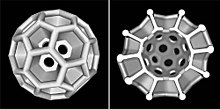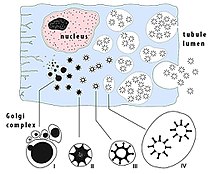


Brochosomes are intricately structured microscopic granules secreted by leafhoppers (the family Cicadellidae of the insect order Hemiptera) and typically found on their body surface and, more rarely, eggs. Brochosomes were first described in 1952 with the aid of an electron microscope. Brochosomes are hydrophobic and help keep the insect cuticle clean. These particles have also been found in samples of air and can easily contaminate foreign objects, which explains erroneous reports of brochosomes on other insects.
The name, derived from the Greek words βρóχoς ("brochos": mesh of a net) and σωμα ("soma": body), refers to the characteristic reticulated surface of the granules.
Structure and composition
Most species of leafhoppers produce hollow spherical brochosomes, 0.2–0.7 micrometres in diameter, with a honeycombed outer wall. They often consist of 20 hexagonal and 12 pentagonal cells, making the outline of each brochosome approximating a truncated icosahedron – the geometry of a soccer ball and a C60 buckminsterfullerene molecule. The chemical composition of brochosomes includes several kinds of proteins and, according to some studies, lipids. The main protein family, called brochosomins, and other kinds of proteins identified in the composition of brochosomes and their corresponding genes show no relationship to proteins and genes of any organisms outside of Membracoidea and thus are considered to be examples of orphan genes.
Origin

Brochosomes are produced within cells of specialized glandular segments of the Malpighian tubules – the primary excretory organs of insects, which often serve additional functions. Each cell simultaneously manufactures a large number of brochosomes within its Golgi complexes and eventually releases them into the lumen of the tubule.
Functions

After each molt, most leafhopper species release droplets of the brochosome-containing fluid through the anus and actively spread them over the newly formed integument. This behavior is called anointing. Dry brochosomes are further distributed across the body and appendages in repeated bouts of grooming, in which leafhoppers scrub themselves with their legs. The transport of brochosomes is facilitated by groups and rows of strong setae on the legs. The resulting coat makes the integument highly repellent to water (superhydrophobic) and to the leafhopper’s own liquid excreta, the latter often being sugary and sticky, and thus potentially dangerous for the insect. Additional protective functions of the brochosomal coating have been hypothesized. For example, there is evidence that the anti reflective property of brochosome make surfaces coated by it appear similar to a leaf in the eyes of insects thus it can be used as camouflage for the eggs.
In several New World genera of the leafhopper subfamily Cicadellinae (including the glassy-winged sharpshooter and related species) brochosomes are also used as a coating on egg masses. In gravid females from these genera, the Malpighian tubules switch over from production of regular brochosomes, described above, to production of larger, typically elongate particles, up to 20 micrometres in length. Prior to laying eggs, the female places masses of such brochosomes onto its forewings, and later scrapes them off onto the freshly laid eggs with its hindlegs. The resulting powdery coat may serve various protective functions, including protection against egg-parasitoids from the order Hymenoptera (Chalcidoidea). The shape and sculpture of such "egg" brochosomes can vary significantly among species, providing additional characteristics for species identification.
References
- ^ Rakitov R. & Gorb S.N. (2013) Brochosomal coats turn leafhopper (Insecta, Hemiptera, Cicadellidae) integument to superhydrophobic state. Proceedings of the Royal Society B 280 (1752). doi:10.1098/rspb.2012.2391.
- Tulloch G.S., Shapiro J.E. & Cochran G.W. (1952) The occurrence of ultramicroscopic bodies with leafhoppers and mosquitoes. Bulletin of the Brooklyn Entomological Society 47: 41-42.
- Day M.F. & M. Briggs (1958) The origin and structure of brochosomes. Journal of Ultrastructure Research 2: 239-244. PMID 13631751
- Wittmaack K. (2005) Brochosomes produced by leafhoppers - a widely unknown, yet highly abundant species of bioaerosols in ambient air. Atmospheric Environment 39: 1173-1180.
- Rakitov R.A. (2011) Contamination as the cause of erroneous records of brochosomes. Psyche: A Journal of Entomology 2011, Article ID 767963, doi:10.1155/2011/767963.
- ^ Rakitov R., Moysa A. A., Kopylov A. T., Moshkovskii S. A., Peters R. S., Meusemann K., Misof B., Dietrich C. H., Johnson K. P., Podsiadlowski L., Walden K. K. O. (2018) Brochosomins and other novel proteins from brochosomes of leafhoppers (Insecta, Hemiptera, Cicadellidae). Insect Biochemistry and Molecular Biology, 94, 10-17.doi:10.1016/j.ibmb.2018.01.001
- ^ Smith D.S. & Littau V.G. (1960) Cellular specialization in the excretory epithelia of an insect, Macrosteles fascifrons Stål (Homoptera). Journal of Cell Biology 8: 103-133.
- ^ Gouranton J. & Maillet P.L. (1967) Origine et structure des brochosomes. Journal de Microscopie 6: 53-64.
- Rakitov R.A. (1999) Secretory products of the Malpighian tubules of Cicadellidae (Hemiptera, Membracoidea): an ultrastructural study. International Journal of Insect Morphology and Embryology 28: 179-192. doi:10.1078/0044-5231-00025
- ^ Rakitov R.A. (2000) Secretion of brochosomes during the ontogenesis of a leafhopper, Oncometopia orbona (F.) (Insecta, Homoptera, Cicadellidae). Tissue & Cell 32: 28-39. PMID 10798315
- Navone P. (1987) Origine, struttura e funzioni di escreti e secreti entomatici di aspetto ceroso distribuiti sul corpo mediante zampe. Annali della Facolta‘ di Scienze Agrarie della Universita‘ degli Studi di Torino 14: 237-294.
- ^ Rakitov R.A. (1996) Post-moulting behaviour associated with Malpighian tubule secretions in leafhoppers and treehoppers (Auchenorrhyncha: Membracoidea). European Journal of Entomology 93: 167-184.
- ^ Rakitov R.A. (2009) Brochosomal coatings of the integument of leafhoppers (Hemiptera, Cicadellidae). In: S.N. Gorb (ed.), Functional Surfaces in Biology, Vol. 1, 113-137. ISBN 978-1-4020-6696-2.
- Rakitov R. & Gorb S.N. (2013) Brochosomes protect leafhoppers (Insecta, Hemiptera, Cicadellidae) from sticky exudates. Journal of the Royal Society Interface 10 (87). doi:10.1098/rsif.2013.0445.
- "Leafhoppers use tiny light-absorbing balls to conceal their eggs". Science News. 2017-11-03. Retrieved 2020-01-31.
- Hix R.L. (2001) Egg-laying and brochosome production observed in glassy-winged sharpshooter. Archived 2016-03-03 at the Wayback Machine California Agriculture 50 (4): 19-22.
- ^ Rakitov R.A. (2004) Powdering of egg nests with brochosomes and related sexual dimorphism in leafhoppers (Insecta, Hemiptera, Cicadellidae). Zoological Journal of the Linnean Society 140: 353-381. doi:10.1111/j.1096-3642.2003.00103.x
- Velema H.P., Hemerik L., Hoddle M.S. & Luck R.F. (2005) Brochosome influence on parasitisation efficiency of Homalodisca coagulata (Say) (Hemiptera: Cicadellidae) egg masses by Gonatocerus ashmeadi Girault (Hymenoptera: Mymaridae). Ecological Entomology 30: 485-496. doi:10.1111/j.0307-6946.2005.00731.x
External links
- Brochosomes by R. A. Rakitov, Illinois Natural History Survey
- Leafhopper Egg Brochosomes Image Database by R. A. Rakitov, Illinois Natural History Survey